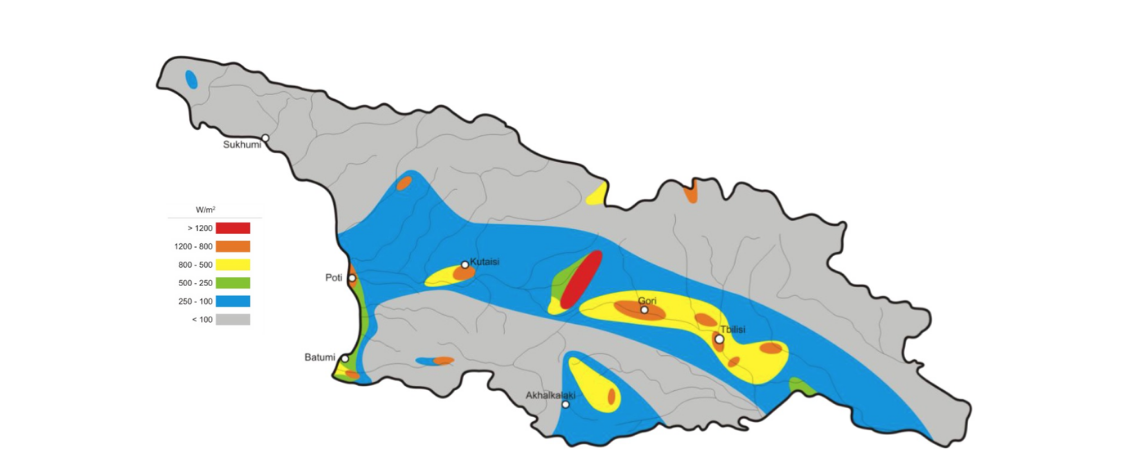
Georgia’s Wind Energy Potential
In recent years, the interest in the construction of wind and solar power plants in Georgia has increased. Therefore, with the help of European consultants DigSILENT, DMCC, R2B consortium, the Georgian Transmission System Operator of Georgia, the GSE, has studied the possibilities of integrating variable renewable energy sources into the Georgian energy system.
The cost of wind turbines and solar panels is decreasing at an increasing pace, making wind and solar energy utilisation more and more attractive. The construction of wind power plants takes much less time than that of hydropower plants (due to the absence of a dam and water pressure system). Their operating expenses are also minimal. Because of delays in the construction of hydropower plants and the intensive growth of the country’s electricity consumption (with the exception of 2020), the use of internal sources is becoming particularly important to ensure the security of supply. Wind and solar power plants can play an important role in this regard. However, their integration should not happen at the expense of reducing the reliability of the power system.
Wind and solar power plants have a number of features that worsen the sustainability of the power system, of which the variability of their generation is particularly noteworthy. This is relatively less pronounced in the case of the sun, as its generation depends mainly on a calendar day and is less dependent on the weather. It is also a positive aspect that the generation of solar power plants can be correlated with the load. That is, as usual, consumption increases during the day. As for the wind, the variability of generation is strongly dependent on the weather, in particular the wind. It is especially noteworthy that in case of strong wind gusts the wind turbines stop working and consequently generate a power deficit, as well as generate harmonic distortion in the network. However, wind generation is virtually impossible to be correlated with consumption. Therefore, special requirements will be required for the reliable operation of the system when using wind and solar energy. Integrating large scale wind farms will be a challenge for the Georgian power system due to the complexity of voltage and frequency regulation. In order to connect wind units to the system, in addition to the conditions provided by the Grid Code, they will have to meet the restrictions, which will be related to the current limitations of the Georgian system.
| Possible allowed capacities to the grid | 25% Wind: 333 MW Solar: 130 MW |
50% Wind: 665 MW Solar: 260 MW |
75% Wind: 1000 MW Solar: 390 MW |
100% Wind: 1330 MW Solar: 520 MW |
|---|---|---|---|---|
| 2020 | Possible | #2a #2c #3 | Impossible | Impossible |
| 2025 | is being estimated | is being estimated | is being estimated | is being estimated |
| 2030 | Possible | #2a #2c | Possible | #2b #4 |
The following factors and measures to be taken into the consideration:
#1 – “Saturation effect” variable G.E. Stations can no longer effectively meet the main goal of integration, can no longer replace thermal power generation and/or imports. The extra energy produced by them directly increases the amount of export or otherwise limited energy.
#2 – Operating variable renewable power plants requires a large amount of regulatory (rump-up and rump-down) reserves in the system. The regulatory reserves in the system are limited and in some cases require additional capacity to increase integration. In particular:
- #2a – The need to find an additional 260 MW gain reserve, which can only be achieved if one additional Enguri unit is used to provide reserves only.
- #2b It is necessary to find an additional 380 MW gain reserve.
- #2c The need to find an additional deduction reserve. It is necessary to have all the so-called Stations should provide reduction reserves of up to 30% of their installed capacity.
#3 – Measures for Frequency Stability (eg Batteries)
#4 – Strengthening the Transmission Network to avoid the overload of transmission lines and transformers when integration Variable Renewable energy
#5. Excess energy generated by renewable energy power plants must be exported or otherwise restricted to some extent:
Technical inter-system exchange opportunities with other countries are sufficient, but
At a particular moment, the market of a neighbouring country should be attractive for export purposes
#6. The significance of the geographical scattering effect when integrating variable renewable energy:
- The maximum geographical dispersion of stations harnessing variable renewable energy sources reduces the reserves required to balance these types of stations.
- This approach enables the maximal integration of variable renewable energy
- Consequently, the concentration of capacity of the renewables at any specific location will limit the possibility of total integration.
Therefore, taking all the above-mentioned restrictions:
- Until 2020-2021 (after the development of balancing mechanisms) it is possible to integrate 333 MW wind and 130 MW solar power plants in the Georgian energy system (25% of the potential)
- By 2025 – estimations are being updated under the Power Generation Development Plan and its results will be announced in the near future.
- By 2030 – Integration of 1332 MW wind and 520 MW solar power plants, forecasted for 2030 (100% of potential)